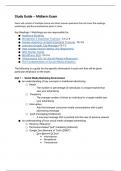Exam (elaborations)
COM 2740 Exam 2 Latest Questions & Correct Answers
- Course
- Institution
What are the different types of segmentation and the differences between them? - Correct Answer *geographic segmentation* is the oldest form of segmentation - the most useful for papers, radio, and tv *demographic segmentation* focuses on gender, ethnicity, age, income, and education - more u...
[Show more]












